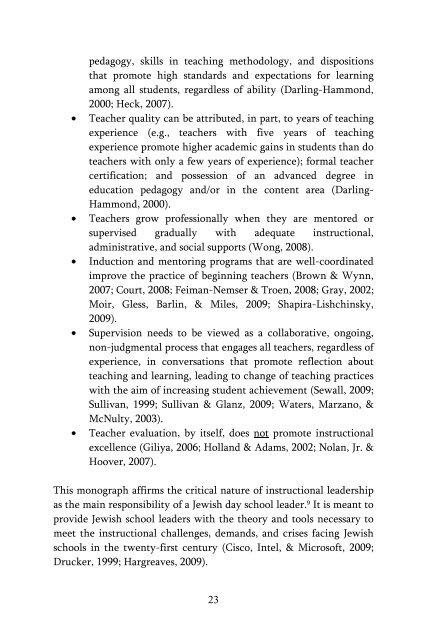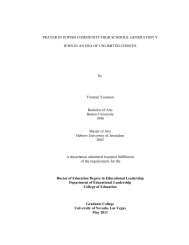constra<strong>in</strong>ts, <strong>in</strong>crease <strong>in</strong> adm<strong>in</strong>istrative report keep<strong>in</strong>g from the centraloffice or board, management of school-wide student behavioral issues,lack of knowledge on how to best engage experienced teachers <strong>in</strong>discussions about teach<strong>in</strong>g practice, among others. Not attend<strong>in</strong>g to<strong>in</strong>struction as the core of what a leader does is not only myopic butdetrimental to optimitz<strong>in</strong>g student learn<strong>in</strong>g. This monograph providesstrategies for balanc<strong>in</strong>g managerial responsibilities with quality timeto improve teach<strong>in</strong>g <strong>in</strong> classrooms <strong>and</strong> school-wide.At this po<strong>in</strong>t, an important caveat must be noted. These cutt<strong>in</strong>gedge practices are likely to fall short without strategic attention <strong>in</strong> aschool. In other words, <strong>in</strong>structional supervisory practices need to beconceived as part of a larger more encompass<strong>in</strong>g strategic <strong>in</strong>itiative toimprove the school <strong>and</strong> thus receive ongo<strong>in</strong>g support, f<strong>in</strong>ancial <strong>and</strong>otherwise. Strategic plann<strong>in</strong>g is time consum<strong>in</strong>g <strong>and</strong> labor <strong>in</strong>tensive.It <strong>in</strong>volves deep reflection, vision<strong>in</strong>g, goal sett<strong>in</strong>g, strategydevelopment, wide collaboration, strategic th<strong>in</strong>k<strong>in</strong>g <strong>and</strong> action, <strong>and</strong>discipl<strong>in</strong>ed follow-through. Supervisory practices need “front seat”attention <strong>in</strong> such a plan. When conceived as such, these supervisory<strong>in</strong>itiatives are more likely to be susta<strong>in</strong>ed, ref<strong>in</strong>ed, <strong>and</strong> ongo<strong>in</strong>g. Theybecome part of the school’s culture <strong>and</strong> thus go beyond the purview ofjust one person, i.e. pr<strong>in</strong>cipal or head of school. <strong>Instructional</strong>supervision becomes endemic <strong>and</strong> endur<strong>in</strong>g (Davies & Davies, 2006;Eacott, 2008; Glanz, 2010; 2010b; Sullivan & Glanz, 2006).Central to the work of <strong>Jewish</strong> day school leaders should be theircommitment to further the professional growth of teachers. Onecannot assume that s<strong>in</strong>ce newly-hired teachers have earned a master’sdegree their education ceases. Cont<strong>in</strong>ued professional development 8 <strong>in</strong>an ongo<strong>in</strong>g manner is critical to improv<strong>in</strong>g teacher quality (Dorph &Holtz, 2000). My read of extant research on teacher quality <strong>in</strong>dicatesthat:• Teach<strong>in</strong>g quality matters <strong>in</strong> terms of promot<strong>in</strong>g studentacademic achievement (Billet, Dru<strong>in</strong>, Hisiger, & Leibtag, 2009;Moir, Barl<strong>in</strong>, Gless, & Miles, 2009; National Research Council,2010; Perk<strong>in</strong>s, 2009).• Teach<strong>in</strong>g quality cannot be attributed to any one factor.Rather, effective teachers exhibit deep knowledge of theircontent specialization, knowledge of best practices <strong>in</strong>22
pedagogy, skills <strong>in</strong> teach<strong>in</strong>g methodology, <strong>and</strong> dispositionsthat promote high st<strong>and</strong>ards <strong>and</strong> expectations for learn<strong>in</strong>gamong all students, regardless of ability (Darl<strong>in</strong>g-Hammond,2000; Heck, 2007).• Teacher quality can be attributed, <strong>in</strong> part, to years of teach<strong>in</strong>gexperience (e.g., teachers with five years of teach<strong>in</strong>gexperience promote higher academic ga<strong>in</strong>s <strong>in</strong> students than doteachers with only a few years of experience); formal teachercertification; <strong>and</strong> possession of an advanced degree <strong>in</strong>education pedagogy <strong>and</strong>/or <strong>in</strong> the content area (Darl<strong>in</strong>g-Hammond, 2000).• Teachers grow professionally when they are mentored orsupervised gradually with adequate <strong>in</strong>structional,adm<strong>in</strong>istrative, <strong>and</strong> social supports (Wong, 2008).• Induction <strong>and</strong> mentor<strong>in</strong>g programs that are well-coord<strong>in</strong>atedimprove the practice of beg<strong>in</strong>n<strong>in</strong>g teachers (Brown & Wynn,2007; Court, 2008; Feiman-Nemser & Troen, 2008; Gray, 2002;Moir, Gless, Barl<strong>in</strong>, & Miles, 2009; Shapira-Lishch<strong>in</strong>sky,2009).• Supervision needs to be viewed as a collaborative, ongo<strong>in</strong>g,non-judgmental process that engages all teachers, regardless ofexperience, <strong>in</strong> conversations that promote reflection aboutteach<strong>in</strong>g <strong>and</strong> learn<strong>in</strong>g, lead<strong>in</strong>g to change of teach<strong>in</strong>g practiceswith the aim of <strong>in</strong>creas<strong>in</strong>g student achievement (Sewall, 2009;Sullivan, 1999; Sullivan & Glanz, 2009; Waters, Marzano, &McNulty, 2003).• Teacher evaluation, by itself, does not promote <strong>in</strong>structionalexcellence (Giliya, 2006; Holl<strong>and</strong> & Adams, 2002; Nolan, Jr. &Hoover, 2007).This monograph affirms the critical nature of <strong>in</strong>structional leadershipas the ma<strong>in</strong> responsibility of a <strong>Jewish</strong> day school leader. 9 It is meant toprovide <strong>Jewish</strong> school leaders with the theory <strong>and</strong> tools necessary tomeet the <strong>in</strong>structional challenges, dem<strong>and</strong>s, <strong>and</strong> crises fac<strong>in</strong>g <strong>Jewish</strong>schools <strong>in</strong> the twenty-first century (Cisco, Intel, & Microsoft, 2009;Drucker, 1999; Hargreaves, 2009).23
- Page 1 and 2: Improving InstructionalQuality in J
- Page 4 and 5: Appendix C: Assessing Your Role as
- Page 6 and 7: others, involved in a cognate enter
- Page 8 and 9: Weissberg, Walberg, & Wang., 2004).
- Page 10 and 11: all. “We are never asked for what
- Page 12 and 13: administrator. He was well-organize
- Page 14 and 15: Sartoris, DiPrima Bickel, & Garnier
- Page 16 and 17: grade conferences, etc., effective
- Page 18 and 19: school’s teaching practices, the
- Page 20 and 21: een made in the areas of science an
- Page 22 and 23: learning is more likely to occur th
- Page 24 and 25: content, and the need to ensure tha
- Page 26 and 27: pattern.] I didn’t really realize
- Page 30 and 31: The Transformational Change Project
- Page 32 and 33: that are not strategic, but episodi
- Page 34 and 35: my personal involvement in work wit
- Page 36 and 37: schools to even greater levels of s
- Page 38 and 39: was: “Well, you know, finding tim
- Page 40 and 41: called direct teaching), although e
- Page 42 and 43: surprised when no one can answer
- Page 44 and 45: RecommendationsI. Teaching1. Teache
- Page 46 and 47: standards,” a significant opportu
- Page 48 and 49: decide on an area or theme they’d
- Page 50 and 51: • Reflective journaling - Another
- Page 52 and 53: 3. Deep instructional improvement v
- Page 54 and 55: Instructional leadership is about e
- Page 56 and 57: 76). Teachers who employ instructio
- Page 58 and 59: short answers to two questions. The
- Page 60 and 61: may become involved in cooperative
- Page 62 and 63: utilized within a differentiated le
- Page 64 and 65: Research-Based Teaching Practices i
- Page 66 and 67: curriculum? Schools, in my view, to
- Page 68 and 69: learning objectives have been ident
- Page 70 and 71: Developing curriculum at the planni
- Page 72 and 73: 4) Emphasize both the academic and
- Page 74 and 75: An Overview of Best Practices in Su
- Page 76 and 77: with practices best suited to promo
- Page 78 and 79:
dialogue and meaningful supervision
- Page 80 and 81:
• Ongoing - Too much of professio
- Page 82 and 83:
to do so. In fact, utilizing in-sch
- Page 84 and 85:
greatly to meaningful supervision a
- Page 86 and 87:
and amplified by James MacGregor Bu
- Page 88 and 89:
Leadership is predicated on the fou
- Page 90 and 91:
Citing Jim Collins (2002 cited by F
- Page 92 and 93:
Notes1. Before continuing, I sugges
- Page 94 and 95:
ubric of “professional developmen
- Page 96 and 97:
throughs, explains that according t
- Page 98 and 99:
members are not fully cognizant or
- Page 100 and 101:
AcknowledgementsI thank all the ind
- Page 102 and 103:
Bass, B. M. (1985). Leadership and
- Page 104 and 105:
Burke, P. J., & Krey, R. D. (2005).
- Page 106 and 107:
Downey, C. J., Steffy, B. E., Posto
- Page 108 and 109:
Fullan, M. (2005). Leadership and s
- Page 110 and 111:
Good, T., & Brophy, J. E. (2007). L
- Page 112 and 113:
Johnson, C. C., & Fargo, J. D. (201
- Page 114 and 115:
Marzano, R. J., & Brown, J. L. (200
- Page 116 and 117:
Popham, W. J. (2008a). Classroom as
- Page 118 and 119:
Shapira-Lishchinsky, O. (2009). Isr
- Page 120 and 121:
Tschannen-Moran, M., & McMaster, P.
- Page 122 and 123:
Annotated Works on Instructional Le
- Page 124 and 125:
This volume is an inspiring introdu
- Page 126 and 127:
you want to learn how to teach stud
- Page 128 and 129:
AppendicesAppendix A: Instructional
- Page 130 and 131:
Suggested responses:1. To be effect
- Page 132 and 133:
Appendix C: Assessing Your Role as
- Page 134 and 135:
SA A D SD 3. My spoken language as
- Page 136 and 137:
Domain 2: The Classroom Environment
- Page 138 and 139:
SA A D SD 13. I have a well-defined
- Page 140 and 141:
SA A D SD 13. I rarely desire to se
- Page 142 and 143:
20. This is a well managed school.
- Page 144 and 145:
Appendix F: Teacher Attitude Questi
- Page 146:
41. My colleagues and I usually dis










